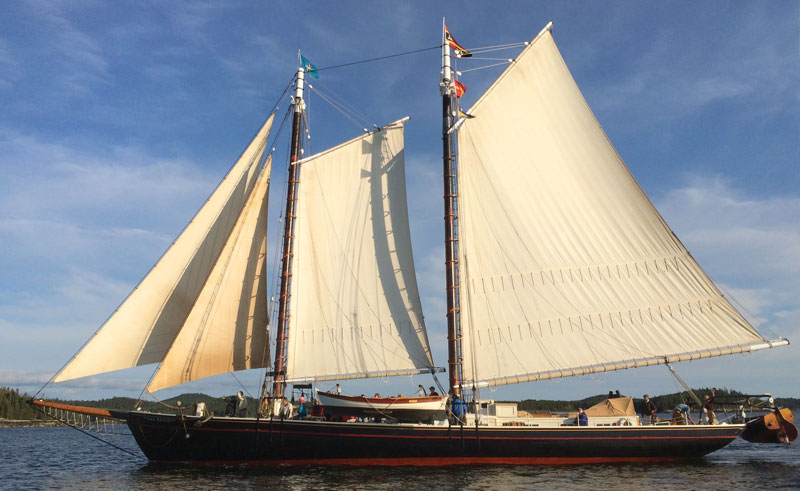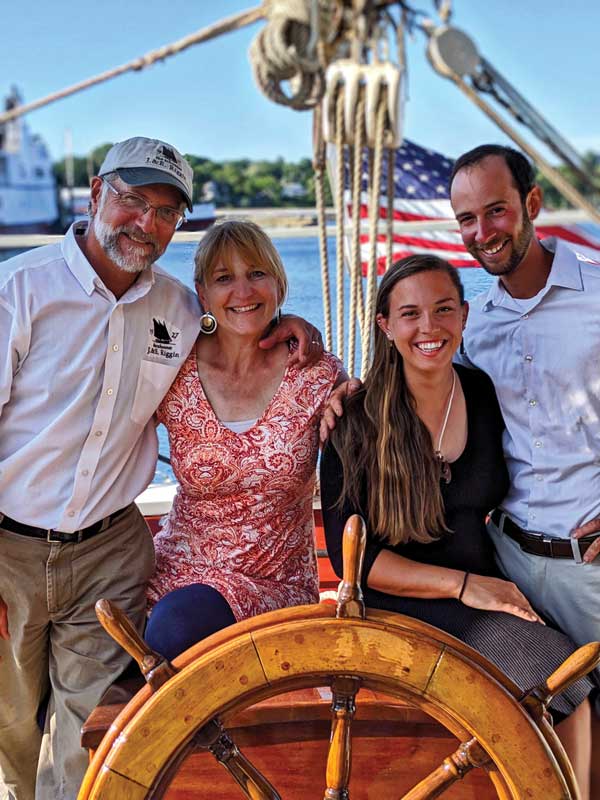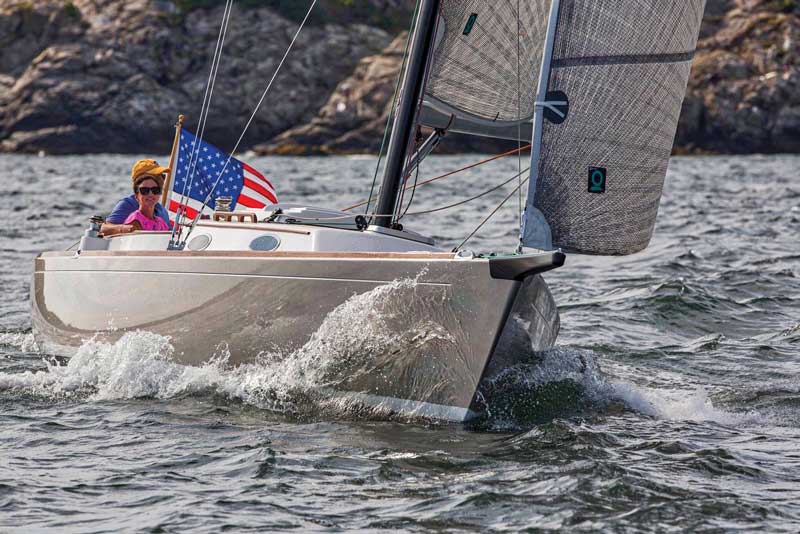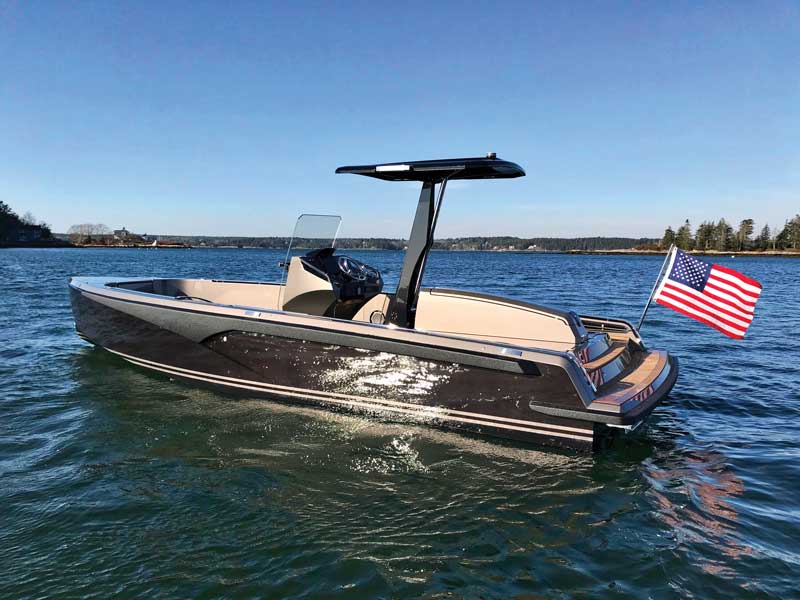 The J. & E. Riggin under sail.
The J. & E. Riggin under sail.
New hands at an old schooner’s helm
 Jon Finger, Annie Mahle, Jocelyn Schmidt, and Justin Schaefer.As a young boy Justin Schaefer took a sailing trip with his parents on the schooner J. & E. Riggin in Penobscot Bay. Eighteen years later, he will realize a lifelong dream to become the owner of the historic schooner. In the fall of 2020, Captain Jon Finger and chef Annie Mahle, owners of the J. & E. Riggin for the past 23 years, will pass the baton of stewardship to Schaefer and his wife, Jocelyn Schmidt.
Jon Finger, Annie Mahle, Jocelyn Schmidt, and Justin Schaefer.As a young boy Justin Schaefer took a sailing trip with his parents on the schooner J. & E. Riggin in Penobscot Bay. Eighteen years later, he will realize a lifelong dream to become the owner of the historic schooner. In the fall of 2020, Captain Jon Finger and chef Annie Mahle, owners of the J. & E. Riggin for the past 23 years, will pass the baton of stewardship to Schaefer and his wife, Jocelyn Schmidt.
Schaefer worked on the schooner as a teenage apprentice and then as a professional member of the crew. He even met Schmidt while sailing on the boat.
Schmidt grew up in Ohio and found her way to the tall ship community on a Caribbean study abroad in 2012. In 2015, she met Schaefer on the schooner dock in Rockland. After their engagement, they moved to Florida to work on yachts, all the while dreaming of moving back to this great state to buy a windjammer of their own.
Although the sale will close next fall, Schaefer will sail on the Rockland, Maine-based passenger schooner this summer with Finger and Mahle, to learn the ropes.
Built in 1927 in New Jersey, the J. & E. Riggin (89' on deck, beam 23', and LOA 120') began life as an oyster dredger. Dave and Sue Allen bought her into the Maine windjammer fleet in 1977 and ran her for 21 years before handing over the helm to Finger and Mahle. She was designated a National Historic Landmark in 1991. The elegant schooner carries up to 24 passengers on four- and six-day cruises from its port in Rockland.
Mahle, who has published three cookbooks and is working on a fourth, said she looks forward to hitting the road in the fall and exploring the rest of the country, while promoting her books.
“We’re just really proud and honored to be able to pass on the stewardship of this wonderful boat,” she said. “We are so pleased that she will stay in the fleet and we have a young generation who will carry on the tradition.”
Voice-controlled boats
We were intrigued by a press release from the Brunswick Corp., parent company of Mercury Marine, about a concept helm that features an enhanced consumer interface incorporating gesture and voice recognition. The futuristic device was on display at CES 2020, where “tens of thousands of people were able to experience Brunswick’s leading-edge, human-centered development capabilities which deliver technology integration comparable to other sophisticated mobility experiences, for example in automotive and aerospace, and are rapidly evolving in the areas of Autonomy/ADAS, Connectivity, Electrification and Shared-Access models,” the release read.
What we want to know is does this new concept helm know how to make a good landing, and can it take itself out to the mooring without help? Heck, can it help wash the dishes and get teenage boys to clean up their rooms?!
Nor’easter or no-mor’easter?
It’s still winter here in Maine and that means cold air, in particular that dreaded blast of wind and bad weather sometimes known as a nor’easter. We recently read an intriguing essay in the Bangor Daily News speculating on whether the term should be retired.
In addition to debate over how to spell it and what it means, the term “nor’easter” has rather dubious origins, according to the BDN, noting that meteorologists, linguists, and sailors alike have all questioned their veracity. What we know as a nor’easter is a storm that happens in the North Atlantic,
usually in the winter, when warm water from the Gulf Stream meets cold air from the north, forming a massive low-pressure area. The resulting storm can result in lots of rain or snow. It’s called a “nor’easter” because the winds typically come from the northeast. According to the BDN, the earliest reported mention of the term “nor’easter” dates back to 1594, in an English book about seafaring that describes the pronunciations for the 32 points of the compass—as in, nor’-nor’east, west-nor’west, and so on. It’s an ironic term because around here people don’t like to pronounce their Rs.
In the early 2000s, the BDN continued, Edgar Comee, a Brunswick resident and former Navy captain, campaigned against the use of the term nor’easter, sending a blue postcard to journalists, business owners, and anyone else who used the phrase.
“Now hear this!” began the card, which was quoted in the New Yorker in 2005. “The use of nor’easter to describe a northeast storm is a pretentious and altogether lamentable affectation, the odious, even loathsome, practice of landlubbers who would be seen as salty as the sea itself.”
It continues, “You will of course accept my view in this matter in good part and will never again use nor’easter, at least in public, and thus oblige. Your most humble petitioner, Edgar Comee, Chairman, Ad Hoc Committee for Stamping Out Nor’easter.”
It would seem that Comee failed in his mission and the term nor’easter is here to stay. That said, though, we’re looking forward to spring and no more winter storms, whatever they might be called, at least until next winter.
Pass the gas
Seaweed has made a lot of headlines as a hot new commodity along the coast—for skin care, vitamins, compost, and gourmet food products. Now you can add forage to the list. A group of researchers based at East Boothbay’s Bigelow Laboratory for Ocean Sciences are investigating whether feeding seaweed to cows might reduce greenhouse emissions released when cows pass gas, i.e. either burp or fart.
Apparently about a quarter of methane emissions in the United States come from cattle. And researchers say substituting seaweed for hay and other traditional cattle foods can make a huge difference. A major new grant will fund a collaborative effort to test which seaweeds offer the most promise, according to a press release from Bigelow Lab.
Many Maine seaweeds are rich in nutrients. Feeding them to cattle may have the added benefits of improving the health of the animals and even the quality of the soil where they pasture. The $3 million grant from the Shelby Cullom Davis Charitable Fund will enable the team in Maine to search for a seaweed, or blend of seaweeds, that optimizes all these potential benefits. The team will screen seaweeds for compounds that make them good candidates for a feed additive. Next, they will conduct laboratory testing at the University of Vermont to determine if the most promising seaweeds actually do reduce methane production. They plan to conduct feeding trials with grazing herds at Wolfe’s Neck Center for Agriculture and the Environment and the University of New Hampshire in the summer of 2020 and 2021.
Inquiring minds want to know. What will come next? Could seaweed be better than Gasex? Could someone send us a sample?!
Fish farmapolooza
A Dutch aquaculture firm announced plans last winter to build a $110 million land-based fish-farm on a 94-acre piece of land on the oceanfront in Jonesport, the third such large-scale project on the books in Maine. And soon afterward the company, Kingfish Zeeland, said it planned to partner with the University of Maine to lease space at the school’s aquaculture incubator to breed and hatch fish for the company, according to a news story in the Bangor Daily News.
If it gets the necessary approvals, the company plans to build a facility that would produce around 13 million pounds of yellowtail fish a year for the North American seafood market, with possible expansion sometime later.
In addition to the proposed fish farm in Jonesport, Nordic Aquafarms has plans to build a $500 million salmon farm in Belfast, while Whole Oceans plans to develop a $180 million salmon farm at the former Verso Paper mill site in Bucksport.
 Alerion 33 under sail
Alerion 33 under sail
New owner for Alerion Yachts
Peter Eastman, owner of Eastman Boats and Howard Boats of Barnstable, Massachusetts, has purchased Alerion Yachts from Peter Johnstone. Eastman said he plans to extend the Alerion brand across new models and a broader size range, and further grow sales and production beyond Alerion’s recent business turnaround.
“I have loved Alerion Yachts since their inception in 1986,” Eastman said. “It is the pre-eminent daysailer brand of sailboats worldwide. At the October US Sailboat Show in Annapolis, I could not take my eyes off of the most recent models. After expressing interest in the brand to my friend Peter Johnstone, we agreed to terms for my purchase of the brand.”
The sale was completed last December.
Johnstone said he has known Eastman since the two competed on rival sailing teams in high school. Later, they were college sailing team-mates and became lifelong friends.
“Peter expressed his interest in Alerion just as I accepted the CEO role at MJM Yachts,” Johnstone said. “Alerion deserves the full-time attention of an industry pro.”
Eastman plans to continue working with builder Randy Borges and his team at Waterline Systems in Rhode Island. “The assembled build team has 15-20 years of experience with Alerion and represent the best of American boatbuilding talent,” he said.
Since its beginnings in the 1980s, the company has delivered close to 500 Alerion 28s. Additional designs added since the 1980s include the 20, 30, 33, 38, and 41.
Already, 2020 has seen the introduction of the Alerion XL 13-foot “Gentleman’s Single-Hander” and the Alerion 15 Daysailer.
Plastic made from fish guts
A British design student has come up with a novel idea for cutting back on petroleum-based plastic products. Inspired by the idea of making something from things people normally discard, student Lucy Hughes designed a plastic-like material made from fish scales and skin that won her the James Dyson Award. According to an article in Forbes, the 24-year-old Hughes beat out 1,078 entrants from 28 different countries. Not only is Marina Tex made from waste, it’s also biodegradable.
Hughes, who grew up near London, but always has loved spending time near the ocean, was bothered by statistics on plastic waste in the ocean.
Her new invention used red algae to bind the fish waste together. The resulting product is strong, flexible, and translucent—with a feel similar to plastic sheeting. It biodegrades on its own in four to six weeks. One single Atlantic codfish produces enough waste for 1,400 MarinaTex bags.
 The new 8-meter open tender from Hodgdon Tenders
The new 8-meter open tender from Hodgdon Tenders
Hodgdon launches first in a new line of superyacht tenders
Hodgdon Tenders, the superyacht tender division of Hodgdon, has launched a new 8 meter (26'3") open tender—the first in the company’s new Crossover line.
The Crossover line’s naval architecture and styling is by Philippe Cabon and Cyril Le Sourd and the engineering is by Hodgdon Tenders’ in-house team. It has numerous unique features including a folding helm console, retractable carbon fiber T-top, custom wrap-around fender, and water jet drive. Ideal for beach landing. It also includes a bow that opens and folds out to become a platform step for easy beach access.
The tender can carry up to 12 guests, and is powered by single Volvo D3-220 engine.
The Crossover line includes Open, Beachlander, and Limousine tenders ranging from 8.0 meters to 11 meters. Once the tender has been delivered to a European shipyard, Hodgdon’s Service and Support team will re-commission the tender and provide crew training.
Loons holding their own
A haunting tremolo, the wavering call of a loon, is one of the iconic sounds of Maine, and people value it. There’s no better proof of that than the annual Maine Audubon Loon Count. Every year, volunteers head out onto local lakes and ponds in July to count Common Loons. In 2019, a total of 1,414 community scientists participated (up from 1,350 in 2018), covering 292 lakes.
The results have now been compiled. In the southern half of Maine, including all areas south of the 45th parallel, Maine Audubon estimates the 2019 loon population included 3,219 adult loons and 372 chicks. Though numbers were a bit below 2018 numbers, the loon population in Maine appears to be healthy and holding steady, Maine Audubon reported in a press release.
A number of factors may have influenced this year’s findings. Most impactful may have been heavy spring rains which flooded some nests and caused egg loss. (Common Loons can’t walk very well on land and therefore build their nests very close to the water’s edge, making nests susceptible to flooding from high water levels or boat wakes.) Some loon counters also reported loons abandoning nests due to high concentrations of black flies in the early season, as well as more predation from bald eagles and other wildlife.
Loon populations have increased markedly since the count began over three decades ago thanks to a no-wake law, requiring speeds that don’t generate wakes within 200 feet of shore and phased-in bans on types of lead fishing tackle. More results are available at maineaudubon.org/loons.
Grant to help Owl stools “fly”
Owl Furniture, an ergonomic furniture company in Stonington, Maine, was awarded a $15,000 grant from the Maine Technology Institute in late-November to support efforts to develop an innovative new product dubbed the ErgoPro Owl.
Owl Furniture has created ergonomic furniture from sustainably harvested hardwood for more than 10 years. The grant will support the company’s effort to use post-consumer plastic and an injection-mold process to create their patented seat.
“This project combines my passion for ergonomic solutions, with my growing concern for our environment,” says Geoffrey Warner, owner and designer of Owl Furniture. “For years, I’ve been working on a way to market the Owl stool’s revolutionary ergonomics to more customers at an affordable price point, by means of a scalable business model.”
Warner has found a partner in G&G Products, Inc., based in Kennebunk, Maine, which will use CNC machining to produce the mold and recycled seats.
The signature “postural support holes” in the seats of Owl Furniture promote active sitting posture and core strengthening. Owl Furniture plans to bring the commercial, wholesale product to market in 2020.






